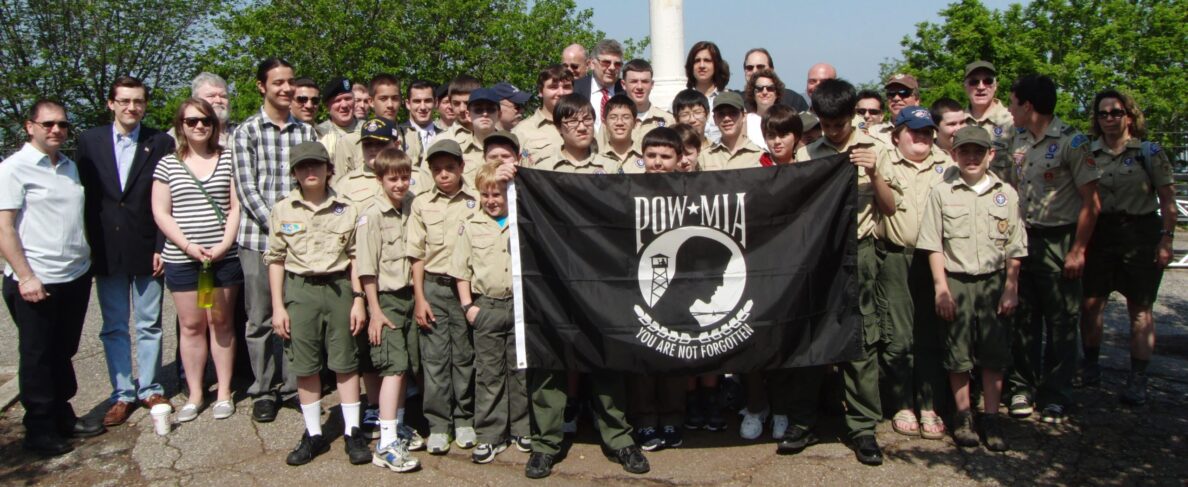Troop 13 is one of the oldest troops in Brooklyn, established in 1948. We are sponsored by St. Anselm R.C. Church and located in St. Anselm School in Bay Ridge Brooklyn. We’re in the Lenape Bay District of the Greater New York Council (Brooklyn) of the Boy Scouts of America. We meet most Mondays from 7pm to 9pm in Meletia-A Hall.
Aims of the Scouting Program
The Boy Scouts of America provides a program for youth that offers effective character development, citizenship training, and personal fitness. The program focuses on defining a boy’s personal qualities, values, and life outlook, learning his obligations to other people, society and our governments and developing physical, mental, and emotional fitness. Fitness includes keeping the body well tuned and healthy, how to think and solve problems, and acquiring self-control, courage, and self-respect.
These aims are achieved in a boy run, planned program that emphasizes:
Ideals. The ideals of Boy Scouting are described in the Scout Oath, Scout Law, Scout Motto and Scout Slogan. A Boy Scout measures himself against these ideals and continually tries to improve. The goals are high, and as he reaches for them, he has some control over what and who he becomes.
Patrols. The patrol method gives Boy Scouts an experience in group living and participating citizenship. It places responsibility on young shoulders and teaches boys how to accept it. The patrol method allows Scouts to interact in small groups where members can easily relate to each other. These small groups determine troop activities through elected representatives.
Outdoor Programs. Scouting is designed to take place outdoors. It is in the outdoor setting that Scouts share responsibilities and learn to live with one another. In the outdoors the skills and activities practiced at troop meetings come alive with purpose. Being close to nature helps Boy Scouts gain an appreciation for the beauty of the world around us. The outdoors is the laboratory in which Boy Scouts learn ecology and practice conservation of nature’s resources.
Advancement. Scouting provides a series of surmountable obstacles and steps in overcoming them through the advancement method. The Boy Scout plans his advancement and progresses at his own pace as he meets each challenge. The Boy Scout is rewarded for each achievement, which helps him gain self-confidence. The steps in the advancement system help a Boy Scout grow in self-reliance and in the ability to help others.
Associations With Adults. Boys learn a great deal by watching how adults conduct themselves. Scout leaders can be positive role models for the members of the troop. In many cases a Scoutmaster who is willing to listen to boys, encourage them, and take a sincere interest in them can make a profound difference in their lives.
Personal Growth. As Boy Scouts plan their activities and progress toward their goals, they experience personal growth. The Good Turn concept is a major part of the personal growth method of Boy Scouting. Boys grow as they participate in community service projects and do Good Turns for others. Probably no device is as successful in developing a basis for personal growth as the daily Good Turn. The religious emblems program also is a large part of the personal growth method. Frequent personal conferences with his Scoutmaster help each Boy Scout to determine his growth toward Scouting’s aims.
Leadership Development. The Boy Scout program encourages boys to learn and practice leadership skills. Every Boy Scout has the opportunity to participate in both shared and total leadership situations. Understanding the concepts of leadership helps a boy accept the leadership role of others and guides him toward the citizenship aim of Scouting.
Uniform. The uniform makes the Boy Scout troop visible as a force for good and creates a positive youth image in the community. Scouting is an action program, and wearing the uniform is an action that shows each Boy Scout’s commitment to the aims and purposes of Scouting. The uniform gives the Boy Scout identity in a world brotherhood of youth who believe in the same ideals. The uniform is practical attire for Boy Scout activities and provides a way for Boy Scouts to wear the badges that show what they have accomplished.
